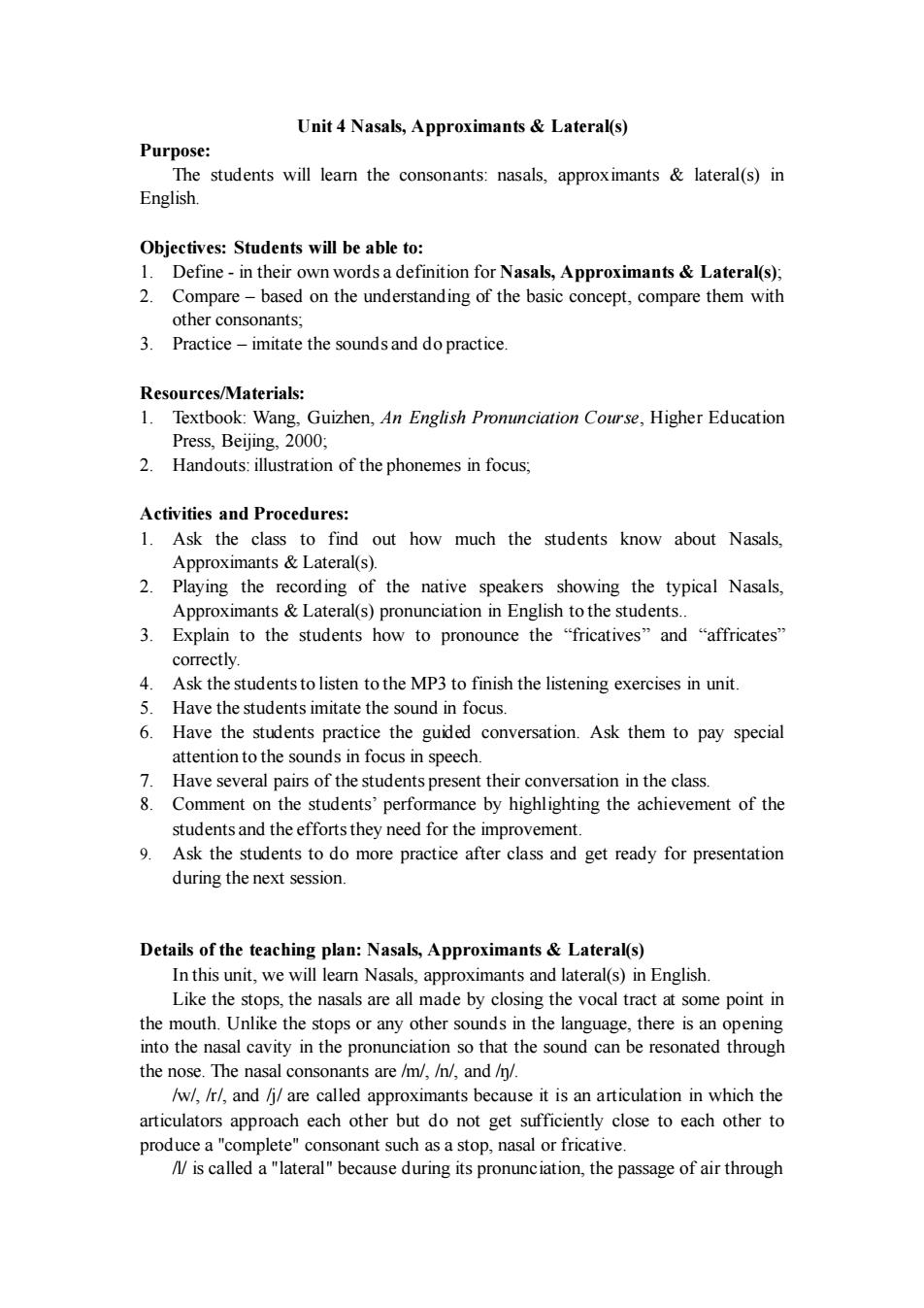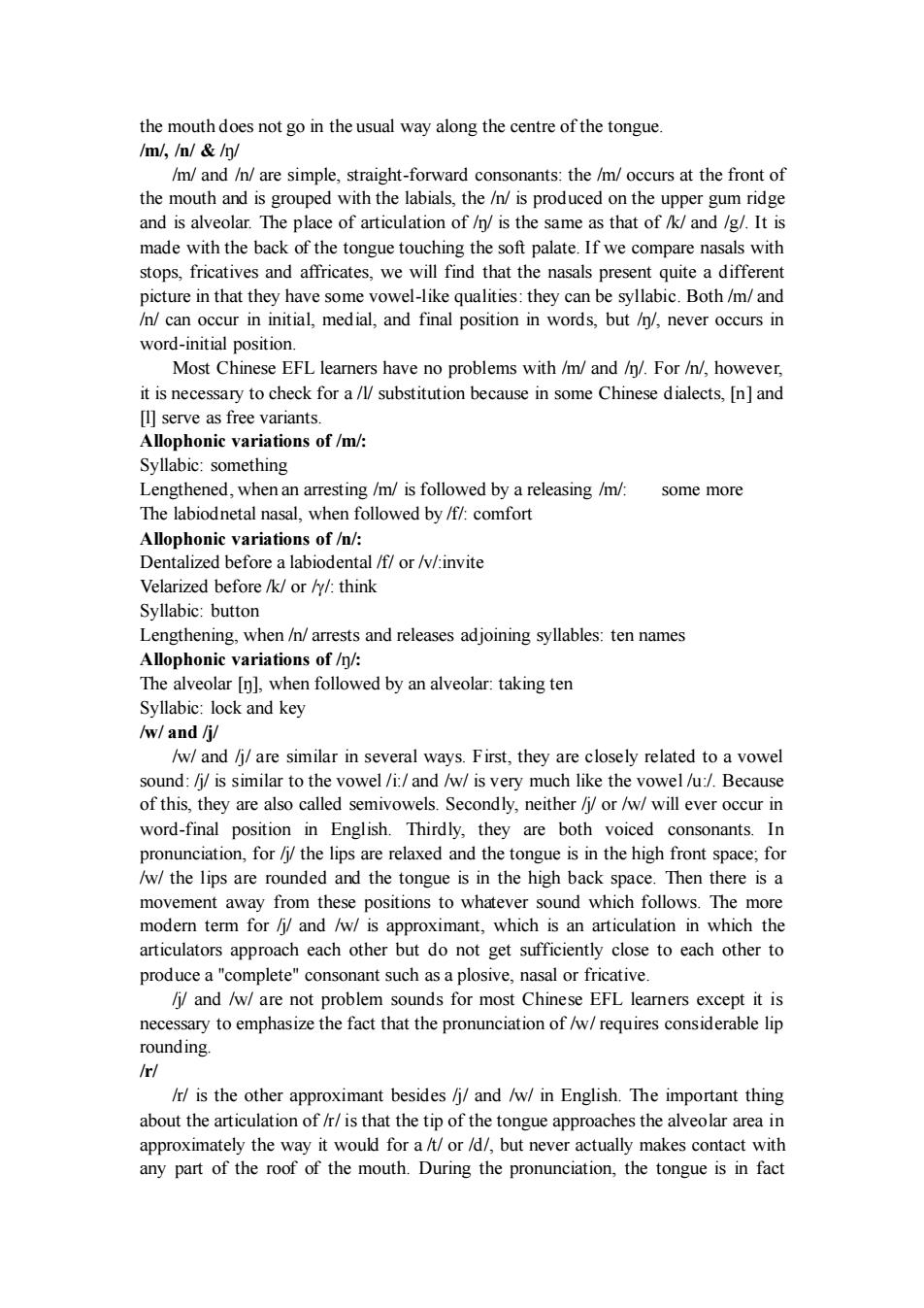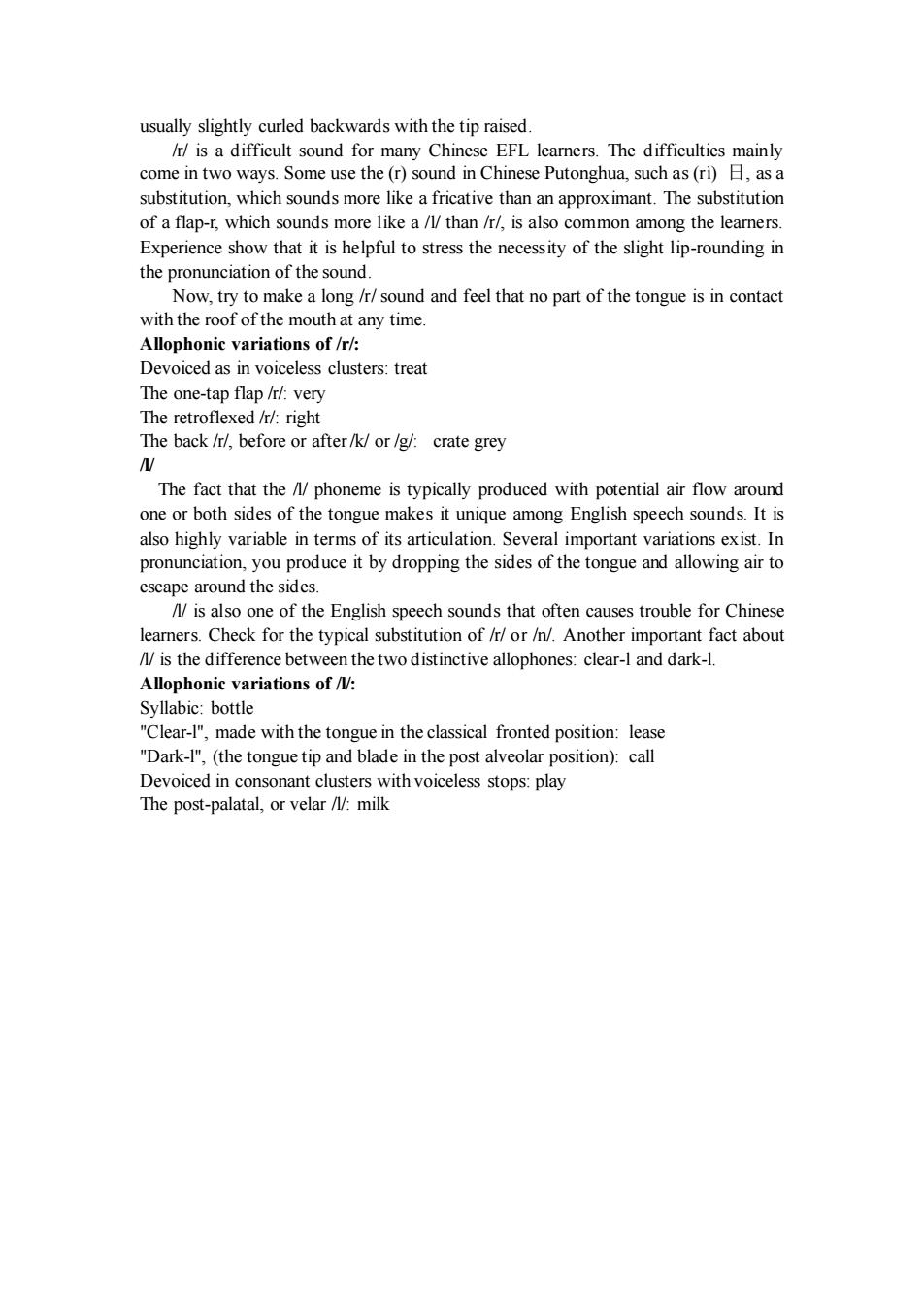
Unit 4 Nasals,Approximants Lateral(s) Purpose e students will lear the consonants:nasals,approximants&lateral(s)in English. Obiectives:Students will be able to: Define-in their own wordsa definition for Nasals,Approximants&Lateral(s) 2. Compare -based on the understanding of the basic concept,compare them with other consonants, 3.Practice-imitate the soundsand do practice. Resources/materials Textbook:Wang. Guizhen,An English Pronunciation Course,Higher Education Press,Beijing.00 2.Handouts:illustration of the phonemes in focus; Activities and Procedures: 1.Ask the to find out how much the students know about Nasals. nts&Lateral(s). 2.Playing the recording of the native speakers showing the typical Nasals, Approximants Lateral(s)pronunciation in English to the students. 3.Explain to the students how to pronounce the "fricatives"and "affricates" 4 Ask the studentstolisten tothe MP3to finish the listening exercises in uni Have the students imitate the sound in focus 6. Have the students practice the guided conversation.Ask them to pay special attention to the sounds in focus in speech 7 Have several pairs of the students present their conversation in the class the students'perfor by highlighting the achievement of the students and the efforts they need for the improvement 9. Ask the students to do more practice after class and get ready for presentation during the next session. Details of the teaching plan:Nasals,Approximants Lateral(s In this unit,we will learn Nasals,approximants and lateral(s)in English. Like the stops,the nasals are all made by closing the vocal tract at some point in the mouth.Unlike the stops or any other sounds in the language.there is an opening the ose The nts are /m/,/n/,and / and j/are called approximants because it is an articulation in which the articulators approach each other but do not get sufficiently close to each other to produce a"complete"consonant such as a stop,nasal or fricative. n/is called a"lateral"because during its pronunciation,the passage of air through
Unit 4 Nasals, Approximants & Lateral(s) Purpose: The students will learn the consonants: nasals, approximants & lateral(s) in English. Objectives: Students will be able to: 1. Define - in their own words a definition for Nasals, Approximants & Lateral(s); 2. Compare – based on the understanding of the basic concept, compare them with other consonants; 3. Practice – imitate the sounds and do practice. Resources/Materials: 1. Textbook: Wang, Guizhen, An English Pronunciation Course, Higher Education Press, Beijing, 2000; 2. Handouts: illustration of the phonemes in focus; Activities and Procedures: 1. Ask the class to find out how much the students know about Nasals, Approximants & Lateral(s). 2. Playing the recording of the native speakers showing the typical Nasals, Approximants & Lateral(s) pronunciation in English to the students. 3. Explain to the students how to pronounce the “fricatives” and “affricates” correctly. 4. Ask the students to listen to the MP3 to finish the listening exercises in unit. 5. Have the students imitate the sound in focus. 6. Have the students practice the guided conversation. Ask them to pay special attention to the sounds in focus in speech. 7. Have several pairs of the students present their conversation in the class. 8. Comment on the students’ performance by highlighting the achievement of the students and the efforts they need for the improvement. 9. Ask the students to do more practice after class and get ready for presentation during the next session. Details of the teaching plan: Nasals, Approximants & Lateral(s) In this unit, we will learn Nasals, approximants and lateral(s) in English. Like the stops, the nasals are all made by closing the vocal tract at some point in the mouth. Unlike the stops or any other sounds in the language, there is an opening into the nasal cavity in the pronunciation so that the sound can be resonated through the nose. The nasal consonants are /m/, /n/, and /ŋ/. /w/, /r/, and /j/ are called approximants because it is an articulation in which the articulators approach each other but do not get sufficiently close to each other to produce a "complete" consonant such as a stop, nasal or fricative. /l/ is called a "lateral" because during its pronunciation, the passage of air through

the mouth does not go in the usual way along the centre of the tongue /m/and /n/are simple,straight-forward consonants:the /m/occurs at the front of the mouth and is grouped with the labials,the /n/is produced on the upper gum ridge and is alveolar.The place of articulation of/n/is the same as that of /k/and /g/.It is made with the back of the tongue touching the soft palate.If we compare nasals with stops,fricatives and affricates,we will find that the nasal present quite ea differer picture in that they have some vowel-like qualities:they can be syllabic.Both/m/and /n/can occur in initial,med ial,and final position in words,but /n/,never occurs in word-initial position. Most Chinese EFL learners have no problems with/m/and /n/.For/n/however it is necessary to check for a/substitution because in some Chinese dialects,[n]and serve as free Allophonic variations of /m/ Svllabic:something Lengthened,when an arresting /m/is followed by a releasing /m/: some more The labiodnetal nasal,when followed by /f/:comfort A llophoni c variatio s of /n/ Dentalized before a labiodental /f/or/v/invite Velarized before/k/or /y/:think Syllabic:button Lengthening,when/n/arrests and releases adjoining syllables:ten names variations of The alveolar when followed by an alveolar:taking ten Syllabic:lock and key w/and /i/ /w/and /i/are similar in several ways.First,they are closely related to a vowel sound:to the is uch like the owel/u/.Bec of this they are also cal lled semivow dly,neither j/or ill ever occur word-final position in English.Thirdly,they are both voiced consonants.In pronunciation,for j/the lips are relaxed and the tongue is in the high front space;for /w/the lips are rounded and the tongue is in the high back space.Then there is a ound which follows The more moder nt,which in which the produce a"complete"consonant such as a plosive,nasal or fricative. /i/and /w/are not problem sounds for most Chinese EFL learners except it is neces ssary to emphasize the fact that the pronunciation of/w/requires considerable lip ounding r/is the other approximant besides/j/and /w/in English.The important thing about the articulation of/r/is that the tip of the tongue approaches the alveolar area in approximately the way it would for a /t/or/d/,but never actually makes contact with any part of the roof of the mouth.During the pronunciation,the tongue is in fact
the mouth does not go in the usual way along the centre of the tongue. /m/, /n/ & /ŋ/ /m/ and /n/ are simple, straight-forward consonants: the /m/ occurs at the front of the mouth and is grouped with the labials, the /n/ is produced on the upper gum ridge and is alveolar. The place of articulation of /ŋ/ is the same as that of /k/ and /g/. It is made with the back of the tongue touching the soft palate. If we compare nasals with stops, fricatives and affricates, we will find that the nasals present quite a different picture in that they have some vowel-like qualities: they can be syllabic. Both /m/ and /n/ can occur in initial, medial, and final position in words, but /ŋ/, never occurs in word-initial position. Most Chinese EFL learners have no problems with /m/ and /ŋ/. For /n/, however, it is necessary to check for a /l/ substitution because in some Chinese dialects, [n] and [l] serve as free variants. Allophonic variations of /m/: Syllabic: something Lengthened, when an arresting /m/ is followed by a releasing /m/: some more The labiodnetal nasal, when followed by /f/: comfort Allophonic variations of /n/: Dentalized before a labiodental /f/ or /v/:invite Velarized before /k/ or //: think Syllabic: button Lengthening, when /n/ arrests and releases adjoining syllables: ten names Allophonic variations of /ŋ/: The alveolar [ŋ], when followed by an alveolar: taking ten Syllabic: lock and key /w/ and /j/ /w/ and /j/ are similar in several ways. First, they are closely related to a vowel sound: /j/ is similar to the vowel /i:/ and /w/ is very much like the vowel /u:/. Because of this, they are also called semivowels. Secondly, neither /j/ or /w/ will ever occur in word-final position in English. Thirdly, they are both voiced consonants. In pronunciation, for /j/ the lips are relaxed and the tongue is in the high front space; for /w/ the lips are rounded and the tongue is in the high back space. Then there is a movement away from these positions to whatever sound which follows. The more modern term for /j/ and /w/ is approximant, which is an articulation in which the articulators approach each other but do not get sufficiently close to each other to produce a "complete" consonant such as a plosive, nasal or fricative. /j/ and /w/ are not problem sounds for most Chinese EFL learners except it is necessary to emphasize the fact that the pronunciation of /w/ requires considerable lip rounding. /r/ /r/ is the other approximant besides /j/ and /w/ in English. The important thing about the articulation of /r/ is that the tip of the tongue approaches the alveolar area in approximately the way it would for a /t/ or /d/, but never actually makes contact with any part of the roof of the mouth. During the pronunciation, the tongue is in fact

usually slightly curled backwards with the tip raised. many Ch substitution,which sounds more like a fricative than an approx imant.The substitution of a flap-r,which sounds more like a/I/than/r/,is also common among the learners. Experience show that it is helpful to stress the necessity of the slight lip-rounding in ciation of the sound make a long/sound and feel that no part of the tongue is in contact with the roof of the mouth at any time. Allophonic variations of/r/: Devoiced as in voiceless clusters:treat The one-tap flap/very The retrofle righ The back//,before or after/k/or/g/:crate grey The fact that the /phoneme is typically produced with potential air flow around one or both sides of the tongue makes it unique among English speech sounds.It is veral important va exist.In tion,you produce it by dropping the sides of the tongue and allowing air to escape around the sides. n/is also one of the English speech sounds that often causes trouble for Chinese learners.Check for the typical substitution of/r/or /n/.Another important fact about /is the difference between the two distinctive allophones:clear-l and dark-1. Allophonic variations of /V: Syllabic:bottle "Clear-1",made with the tongue in the classical fronted position:lease "Dark-1"(the tongue tip and blade in the post alveolar position):call Devoiced in consonant clusters with voiceless stops:play The post-palatal,or velar milk
usually slightly curled backwards with the tip raised. /r/ is a difficult sound for many Chinese EFL learners. The difficulties mainly come in two ways. Some use the (r) sound in Chinese Putonghua, such as (rì) 日, as a substitution, which sounds more like a fricative than an approximant. The substitution of a flap-r, which sounds more like a /l/ than /r/, is also common among the learners. Experience show that it is helpful to stress the necessity of the slight lip-rounding in the pronunciation of the sound. Now, try to make a long /r/ sound and feel that no part of the tongue is in contact with the roof of the mouth at any time. Allophonic variations of /r/: Devoiced as in voiceless clusters: treat The one-tap flap /r/: very The retroflexed /r/: right The back /r/, before or after /k/ or /g/: crate grey /l/ The fact that the /l/ phoneme is typically produced with potential air flow around one or both sides of the tongue makes it unique among English speech sounds. It is also highly variable in terms of its articulation. Several important variations exist. In pronunciation, you produce it by dropping the sides of the tongue and allowing air to escape around the sides. /l/ is also one of the English speech sounds that often causes trouble for Chinese learners. Check for the typical substitution of /r/ or /n/. Another important fact about /l/ is the difference between the two distinctive allophones: clear-l and dark-l. Allophonic variations of /l/: Syllabic: bottle "Clear-l", made with the tongue in the classical fronted position: lease "Dark-l", (the tongue tip and blade in the post alveolar position): call Devoiced in consonant clusters with voiceless stops: play The post-palatal, or velar /l/: milk